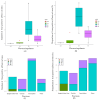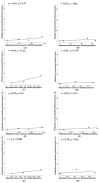Seroprevalence of Anti-SARS-CoV-2 Antibodies in Cats during Five Waves of COVID-19 Epidemic in Thailand and Correlation with Human Outbreaks
- PMID: 38473145
- PMCID: PMC10930909
- DOI: 10.3390/ani14050761
Seroprevalence of Anti-SARS-CoV-2 Antibodies in Cats during Five Waves of COVID-19 Epidemic in Thailand and Correlation with Human Outbreaks
Abstract
Human-to-animal SARS-CoV-2 transmission was observed, including a veterinarian contracting COVID-19 through close contact with an infected cat, suggesting an atypical zoonotic transmission. This study investigated the prevalence of SARS-CoV-2 antibodies in cats during human outbreaks and elucidated the correlation between cat infections and human epidemics. A total of 1107 cat serum samples were collected and screened for SARS-CoV-2 antibodies using a modified indirect ELISA human SARS-CoV-2 antibody detection kit. The samples were confirmed using a cPass™ neutralization test. The SARS-CoV-2 seropositivity rate was 22.67% (199/878), mirroring the trend observed in concomitant human case numbers. The waves of the epidemic and the provinces did not significantly impact ELISA-positive cats. Notably, Chon Buri exhibited a strong positive correlation (r = 0.99, p = 0.009) between positive cat sera and reported human case numbers. Additionally, the cPass™ neutralization test revealed a 3.99% (35/878) seropositivity rate. There were significant differences in numbers and proportions of positive cat sera between epidemic waves. In Samut Sakhon, a positive correlation (r = 1, p = 0.042) was noted between the proportion of positive cat sera and human prevalence. The findings emphasize the need for ongoing surveillance to comprehend SARS-CoV-2 dynamics in both human and feline populations.
Keywords: COVID-19; SARS-CoV-2; Thai; cat; correlation; indirect ELISA; seroprevalence; surrogate viral neutralization assay.
Conflict of interest statement
The authors declare no conflicts of interest.
Figures






Similar articles
-
Prevalence of anti-severe acute respiratory syndrome coronavirus 2 antibodies in cats in Germany and other European countries in the early phase of the coronavirus disease-19 pandemic.Zoonoses Public Health. 2022 Aug;69(5):439-450. doi: 10.1111/zph.12932. Epub 2022 Mar 2. Zoonoses Public Health. 2022. PMID: 35238485 Free PMC article.
-
A cross-sectional serosurvey of SARS-CoV-2 and co-infections in stray cats from the second wave to the sixth wave of COVID-19 outbreaks in Spain.Vet Res Commun. 2023 Jun;47(2):615-629. doi: 10.1007/s11259-022-10016-7. Epub 2022 Oct 14. Vet Res Commun. 2023. PMID: 36229725 Free PMC article.
-
Serological Survey of Retrovirus and Coronavirus Infections, including SARS-CoV-2, in Rural Stray Cats in The Netherlands, 2020-2022.Viruses. 2023 Jul 12;15(7):1531. doi: 10.3390/v15071531. Viruses. 2023. PMID: 37515217 Free PMC article.
-
Understanding the prevalence of SARS-CoV-2 (COVID-19) exposure in companion, captive, wild, and farmed animals.Virulence. 2021 Dec;12(1):2777-2786. doi: 10.1080/21505594.2021.1996519. Virulence. 2021. PMID: 34696707 Free PMC article. Review.
-
[SARS-CoV-2 infections in cats, dogs, and other animal species: Findings on infection and data from Switzerland].Schweiz Arch Tierheilkd. 2021 Dec;163(12):821-835. doi: 10.17236/sat00329. Schweiz Arch Tierheilkd. 2021. PMID: 34881715 Review. German.
Cited by
-
Longitudinal study on SARS-CoV-2 antibody responses in companion animals, Chile.Vet Q. 2025 Dec;45(1):1-12. doi: 10.1080/01652176.2025.2509504. Epub 2025 Jun 4. Vet Q. 2025. PMID: 40465510 Free PMC article.
-
Seroprevalence of SARS-CoV-2 in cats from COVID-19 positive households in the Lisbon area.Front Vet Sci. 2025 Jun 23;12:1542397. doi: 10.3389/fvets.2025.1542397. eCollection 2025. Front Vet Sci. 2025. PMID: 40625705 Free PMC article.
References
-
- Puenpa J., Rattanakomol P., Saengdao N., Chansaenroj J., Yorsaeng R., Suwannakarn K., Thanasitthichai S., Vongpunsawad S., Poovorawan Y. Molecular characterisation and tracking of severe acute respiratory syndrome coronavirus 2 in Thailand, 2020–2022. Arch. Virol. 2023;168:26. doi: 10.1007/s00705-022-05666-6. - DOI - PMC - PubMed
-
- Triukose S., Nitinawarat S., Satian P., Somboonsavatdee A., Chotikarn P., Thammasanya T., Wanlapakorn N., Sudhinaraset N., Boonyamalik P., Kakhong B., et al. Effects of public health interventions on the epidemiological spread during the first wave of the COVID-19 outbreak in Thailand. PLoS ONE. 2021;16:e0246274. doi: 10.1371/journal.pone.0246274. - DOI - PMC - PubMed
-
- Sila T., Sunghan J., Laochareonsuk W., Surasombatpattana S., Kongkamol C., Ingviya T., Siripaitoon P., Kositpantawong N., Kanchanasuwan S., Hortiwakul T., et al. Suspected Cat-to-Human Transmission of SARS-CoV-2, Thailand, July–September 2021. Emerg. Infect. Dis. J. 2022;28:1485. doi: 10.3201/eid2807.212605. - DOI - PMC - PubMed
-
- Gaudreault N.N., Trujillo J.D., Carossino M., Meekins D.A., Morozov I., Madden D.W., Indran S.V., Bold D., Balaraman V., Kwon T., et al. SARS-CoV-2 infection, disease and transmission in domestic cats. Emerg. Microbes Infect. 2020;9:2322–2332. doi: 10.1080/22221751.2020.1833687. - DOI - PMC - PubMed
Grants and funding
LinkOut - more resources
Full Text Sources
Miscellaneous

